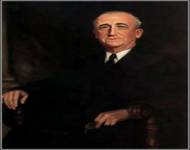Early Life
James Francis Byrnes was born on May 2, 1879 in Charleston, South Carolina. Byrnes’ father died before he was born, and he was raised by his mother, who was a dressmaker. He left school at the age of fourteen to begin working in a law office. Eventually, he became a court stenographer. Byrnes went on to apprentice as a lawyer and then he sat for the bar, which he passed in 1903.
Career
After passing the bar, Byrnes became the district prosecutor in 1908. He then served on the U.S. House of Representatives from 1911 until 1925. After finishing his tenure with the House, Byrnes ran for a Democratic Senate position, which he did not win. After losing the Senate election, Byrnes returned to private practice until 1931.
In 1931, Byrnes again ran for the U.S. Senate, and this time he was elected. He served on the Senate until 1941. During his time with the Senate, Byrnes helped the President Roosevelt’s New Deal through Congress.
Supreme Court
James F. Byrnes served one year and two and a half months on the Supreme Court. The only other Justice who served on the Court for less time than was Byrnes was John Rutledge, who served for a year and eighteen days. He began his tenure with the Supreme Court in July of 1941 and resigned in October 1942. During his short time on the Court, Byrnes wrote sixteen opinions. Byrnes believed strongly that it was the Court’s job to interpret laws, not to make them.
Byrnes chose to resign because he missed the political action he had been a part of as a member of the legislature.
Later Years
After his resignation from the Supreme Court, he was named Director of the Office of Economic Stabilization. In 1943 he was named Director of the Office of War Mobilization and Reconversion.
Byrnes attended the Yalta Conference with Roosevelt in 1945. After President Roosevelt’s death in April 1945, Byrnes went back to South Carolina until President Truman named him Secretary of State a few months later. He later accompanied President Truman to the Potsdam Conference in his capacity as Secretary of State. It was under Byrnes’ advice that the two atomic bombs were dropped on Japan during World War II. Byrnes remained the Secretary State until 1947 when he resigned after some disagreements with the President.
In 1947, Byrnes was named Time Magazine’s Man of the Year for the year 1946.
Byrnes was elected Governor of South Carolina in 1951. During his time as Governor he supported separate but equal education for African Americans. Byrnes poured money into African American schools to do what he could to make them equal to the schools white children attended. South Carolina had a one-term limit for Governor and as such, Byrnes stepped down in 1955.
He died in 1972 at the age of 89.









